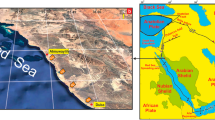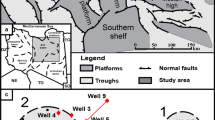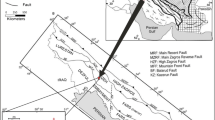Abstract
The Pleistocene was characterized by an unstable meteoric–marine diagenetic environment, influenced by high-amplitude global and regional eustatic variations. This paper focuses on the diagenetic characteristics of the Pleistocene–Holocene reef-carbonate rocks in the well Xike#1, drilled on the Stone Island (part of the Xisha Islands) in the South China Sea. A petrographic, cathodoluminescence and stable isotope study allowed the evaluation of the diagenetic evolution of the reef-carbonate rocks. The rock types present include framestones, packstones, wackestones and grainstones. Rock fabric analysis reveals the existence of skeletal grains, biodetritus, intraclasts, matrix and calcite cements. The upper part of the cored interval (0–180 m) has been heavily altered by meteoric fluids. Unequivocal evidence of meteoric diagenesis includes consistently negative δ18O values, well-developed subaerial exposure horizons and typical vadose cements. The deepest exposure surface is ~ 80 m above the base of meteoric diagenesis, which means that the paleowater table could be extended to as deep as 80 m. The grainstone present at 7.74 m represents the boundary between the vadose and phreatic zones, which is marked by the first appearance of isopachous dogtooth cements and well-developed moldic pores. The reef-carbonate rocks between depths of 21.66 m and 180 m have undergone diagenesis in both meteoric and marine environments, in which the early-stage fibrous marine cements are surrounded by later meteoric drusy calcite cements. The end products of phreatic meteoric diagenesis are the limestones composed of low-Mg calcite with micrite envelopes, moldic pores, blocky spar calcite cementation, and aragonite neomorphism. The interval from 180 to 216 m has undergone a marine diagenesis, which is marked by cements with non-luminescent CL characteristic and a limited, relatively enriched C and O isotope composition. The study reveals that the diagenetic evolution of reef carbonate is mainly controlled by high-frequency eustatic sea-level changes, while the sedimentation rate variations, which were induced by regional subsidence and nutrient variations could also have had an impact on the diagenetic evolution.












Similar content being viewed by others
References
Allan JR, Matthews RK (1977) Carbon and oxygen isotopes as diagenetic and stratigraphic tools: surface and subsurface data, Barbados, West Indies. Geology 5:16–20
Allan JR, Matthews RK (1982) Isotope signatures associated with early meteoric diagenesis. Sedimentology 29:797–817
Benito MI, Mas R (2006) Sedimentary evolution of the Torrecilla Reef Complex in response to tectonically forced regression (Early Kimmeridgian, Northern Spain). Sediment Geol 183:31–49
Buchbinder LG, Friedman GM (1980) Vadose, phreatic, and marine diagenesis of Pleistocene–Holocene carbonates in a borehole: mediterranean coast of Israel. J Sediment Res 50:395–408
Budd DA (1988) Aragonite-to-calcite transformation during freshwater diagenesis of carbonates. Geol Soc Am Bull 100:1260–1270
Budd DA, Land LS (1990) Geochemical imprint of meteoric diagenesis in Holocene ooid sands, Schooner Cays, Bahamas: correlation of calcite cement geochemistry with extant groundwaters. J Sediment Res 60:361–378
Chen M, Huang C, Pflaumann U, Waelbroeck C, Kucera M (2005) Estimating glacial western Pacific sea-surface temperature: methodological overview and data compilation of surface sediment planktic foraminifer faunas. Quat Sci Rev 24:1049–1062
Dunham RJ (1962) Classification of carbonate rocks according to depositional texture. Memoir Am Ass Pet Geol 1:108–121
Embry A, Klovan JE (1971) A late Devonian reef tract on northeastern Banks Island, northwest territories. Bull Can Pet Geol 19:730–781
Follows EJ (1992) Patterns of reef sedimentation and diagenesis in the Miocene of Cyprus. Sediment Geol 79:225–253
Fox DL, Honey JG, Martin RA, Pelaez-Campomanes P (2012) Pedogenic carbonate stable isotope record of environmental change during the Neogene in the southern Great Plains, southwest Kansas, USA: oxygen isotopes and paleoclimate during the evolution of C4-dominated grasslands. Geol Soc Am Bull 124:431–443
Gavish E, Friedman GM (1969) Progressive diagenesis in Quaternary to Late Tertiary carbonate sediments: sequence and time scale. J Sediment Petrol 39:980–1006
Gischler E, Thomas AL, Droxler AW, Webster JM, Yokoyama Y, Schne BR (2013) Microfacies and diagenesis of older Pleistocene (pre-last glacial maximum) reef deposits, Great Barrier Reef, Australia (IODP Expedition 325): a quantitative approach. Sedimentology 60:1432–1466
Gonzalez LA, Lohnmann KC (1985) Carbon and oxygen isotopic composition in Holocene reefal carbonates. Geology 13:811–814
Halley RB (1979) Freshwater cementation of a 1000-year-old oolite. J Sediment Petrol 49:969–988
Hallock P, Schlager W (1986) Nutrient excess and the demise of coral reefs and carbonate platforms. Palaios 1:389–398
He QX, Zhang MS (1990) Origin of Neogene dolomites in Xisha Islands and their significance. Mar Geol Quat Geol 10:45–55 (in Chinese with English abstract)
Huang C, Wu S, Zhao M, Chen M, Wang C, Tu X, Yuan PB (1997) Surface ocean and monsoon climate variability in the South China Sea since the last glaciation. Mar Micropaleontol 32:71–94
James NO, Choquette PW (1984) Diagenesis 9: limestones- the meteoric diagenetic environment. Geosci Can 11:161–194
Kindler P, Mazzolini D (2001) Sedimentology and petrography of dredged carbonate sands from stocking Island (Bahamas): implications for meteoric diagenesis and aeolianite formation. Palaeogeogr Palaeoclimatol Palaecol 175:369–379
Kumar SK, Chandrasekar N, Seralathan P, Sahayam JD (2012) Diagenesis of Holocene reef and associated beachrock of certain coral islands, Gulf of Mannar, India: implication on climate and sea level. J Earth Syst Sci 121:733–745
Lambeck K, Esat TM, Potter E-K (2002) Links between climate and sea levels for the past three million years. Nature 419:199–206
Li R, Jones B (2013a) Temporal and spatial variations in the diagenetic fabrics and stable isotopes of Pleistocene corals from the Ironshore Formation of Grand Cayman, British West Indies. Sediment Geol 286–287:58–72
Li R, Jones B (2013b) Heterogeneous diagenetic patterns in the Pleistocene Ironshore Formation of Grand Cayman, British West Indies. Sediment Geol 294:251–265
Li R, Qiao PJ, Cui YC, Zhang DJ, Liu XY, Shao L (2018) Composition and diagenesis of Pleistocene aeolianites at Shidao, Xisha Islands: implications for palaeoceanography and palaeoclimate during the last glacial period. Palaeogeogr Palaeoclimatol Palaeoecol 490:604–616
Lincoln JM, Schlanger SO (1987) Miocene sea-level falls related to the geologic history of Midway Atoll. Geology 15:454–457
Liu J, Ye ZZ, Han CR, Liu XB, Qu GS (1997) Meteoric diagenesis in Pleistocene reef limestones of Xisha Islands, China. J Asian Earth Sci 15:465–476
Liu J, Han CR, Wu JZ, Ju LJ (1998) Geochemical evidence for the meteoric diagenesis in Pleistocene reef limestones of Xisha Islands. Acta Sedimentol Sin 16:71–77 (in Chinese with English abstract)
Longman MW (1980) Carbonate diagenetic textures from near surface diagenetic environment. Am Assoc Pet Geol Bull 64:461–487
Ma ZL, Li QY, Liu XY, Luo W, Zhang DJ, Zhu YH (2018) Palaeoenvironmental significance of Miocene larger benthic foraminifera from the Xisha Islands, South China Sea. Palaeoworld 27:145–157
Major RP, Matthews RK (1983) Isotopic composition of bank margin carbonates on Midway Atoll: amplitude constraint on post-early Miocene eustasy. Geology 11:335–338
Martindale RC, Bottjer DJ, Corsetti FA (2012) Platy coral patch reefs from eastern Panthalassa (Nevada, USA): unique reef construction in the Late Triassic. Palaeogeogr Palaeoclimatol Palaeoecol 313–314:41–58
McCrea JM (1950) On the isotopic chemistry of carbonates and a paleotemperature scale. J Chem Phys 18:849–857
Melim LA (1996) Limitations on lowstand meteoric diagenesis in the Pliocene-Pleistocene of Florida and Great Bahama Bank: implications for eustatic sea-level models. Geology 10:893–896
Melim LA, Swart PK, Eberli GP (2004) Mixzong-zone diagenesis in the subsurface of Florida and the Bahamas. J Sediment Res 74:904–913
Miller KG, Kominz MA, Browning JV, Wright JD, Mountain GS, Katz ME, Sugarman PJ, Cramer BS, Christie-Blick N, Pekar SF (2005) The Phanerozoic record of global sea-level change. Science 310:1293–1298
Pelejero C, Grimalt JO, Heilig S, Kienast M, Wang L (1999) High-resolution UK37 temperature reconstructions in the South China Sea over the past 220 kyr. Paleoceanography 14:224–231
Qiao PJ, Zhu WL, Shao L, Zhang DJ, Cheng XR, Song YM (2015) Carbonate stable isotope stratigraphy of well Xike-1, Xisha Islands. Earth Sci 40:725–732 (in Chinese with English abstract)
Quade J, Roe LJ (1999) The stable-isotope composition of early ground-water cements from sandstone in paleoecological reconstruction. J Sediment Res 69:667–674
Quinn TM (1991) Meteoric diagenesis of Plio-Pleistocene limestones at Enewetak Atoll. J Sediment Petrol 61:681–703
Saller AH, Moore CH (1989) Meteoric diagenesis, marine diagenesis, and microporosity in Pleistocene and Oligocene limestones, Enewetak Atoll, Marshall Islands. Sediment Geol 63:253–272
Shao L, Cui YC, Qiao PJ, Zhang DJ, Liu XY, Zhang CL (2017) Sea-level changes and carbonate platform evolution of the Xisha Islands (South China Sea) since the Early Miocene. Palaeogeogr Palaeoclimatol Palaeoecol 485:504–516
Singh S, Parkash B, Awasthi AK, Singh T (2012) Palaeoprecipitation record using O-isotope studies of the Himalayan Foreland Basin sediments, NW India. Palaeogeogr Palaeoclimatol Palaeoecol 331–332:39–49
Solihuddin T, Collins LB, Blakeway D, O’Leary MJ (2015) Holocene coral reef growth and sea level in a macrotidal, high turbidity setting: cockatoo Island, Kimberley Bioregion, northwest Australia. Mar Geol 359:50–60
Steinen RP, Matthews RK (1973) Phreatic vs. vadose diagenesis: stratigraphy and mineralogy of a cored borehole on Barbados, W.I. J Sediment Petrol 43:1012–1020
Swart PK, Oehlert AM (2018) Revised interpretations of stable C and O patterns in carbonate rocks resulting from meteoric diagenesis. Sediment Geol 364:14–23
Tucker ME (2001) Carbonate reservoirs: porosity evolution and diagenesis in sequence stratigraphic framework, vol 55. Elsevier, Amsterdam, p 444
Tucker ME, Wright VP, Dickson JAD (2008) Carbonate sedimentology. Blackwell Science Ltd, Hoboken
Vollbrecht R (1990) Marine and meteoric diagenesis of submarine Pleistocene carbonates from the Bermuda carbonate platform. Carbonates Evaporites 5:13–95
Vollbrecht R, Meischner D (1996) Diagenesis in coastal carbonates related to Pleistocene sea level, Bermuda platform. J Sediment Res 66:243–258
Waelbroeck C, Labeyrie L, Michel E, Duplessy JC, McManus JF, Lambek K, Balbon E, Labracherie M (2002) Sea-level and deep water temperature changes derived from benthic foraminifera isotopic records. Quat Sci Rev 21:295–305
Wang ZF, Zhang DJ, Liu X, You L, Luo W, Yi L, Tan L, Zhu Y, Qin H, Cheng H, Li Z, Xie Q, Che Z, Deng C, Zhu R (2017) Magnetostratigraphy and 230Th dating of Pleistocene biogenic reefs in XK-1 borehole from Xisha Islands, South China Sea. Chin J Geophys 60:1027–1038 (in Chinese with English abstract)
Wang Z, Huang K, Zhang D, You L, Liu X, Luo W (2018) Maturation of Neogene dolomite from Xuande Atoll of Xisha archipelago, the South China Sea. Mar Pet Geol 92:51–64
Woodroffe CD, Webster JM (2014) Coral reefs and sea-level change. Mar Geol 352:248–267
Wu S, Yang Z, Wang D, Lü F, Lüdmann T, Fulthorpe C, Wang B (2014) Architecture, development and geological control of the Xisha carbonate platforms, northwestern South China Sea. Mar Geol 350:71–83
Wu F, Xie XN, Betzler C, Zhu WL, Zhu YH, Guo LY, Ma ZL, Bai HQ, Ma BJ (2019) The impact of eustatic sea-level fluctuations, temperature variations and nutrient-level changes since the Pliocene on tropical carbonate platform (Xisha Islands, South China Sea). Palaeogeogr Palaeoclimatol Palaeoecol 514:373–385
Yasukochi T, Kayanne H, Yamaguchi T, Yamano H (2014) Sedimentary facies and Holocene depositional processes of Laura Island, Majuro Atoll. Geomorphology 222:59–67
Ye YG, Wang XE, Diao SB (1987) A preliminary study on the reliability of radiocarbon age from Shidao Island of Xisha Archipelago. Mar Geol Quat Geol 7:121–130 (in Chinese with English abstract)
Ye YG, He J, Diao SB, Gao CJ, Du YJ (1990) 14C and ESR ages of eolian calcarenite from Shidao Island of Xisha Island. Mar Geol Quat Geol 10:103–110 (in Chinese with English abstract)
Ye YG, He J, Diao SB, Liu X, Gao J Du YJ (1991) ESR chronology of well Xi-Chen-1. In: Correlation of onshore and offshore quaternary in China. Science Press, Beijing, pp 224–233 (in Chinese with English abstract)
Zhai SK, Mi LJ, Shen X, Liu XY, Xiu C, Sun ZP, Cao JQ (2015) Mineral compositions and their environmental implications in reef of Shidao Island, Xisha. Earth Sci J China Univ Geol 40:597–602 (in Chinese with English abstract)
Zhang MS (1990) Quaternary reef stratigraphic division in Hole Xiyong-1. Mar Geol Quat Geol 10:57–64 (in Chinese with English abstract)
Zhang MS, He QX, Ye ZZ, Han C, Li H, Wu J, Ju L (1989) Sedimentological studies of Xisha Organic reef carbonates. Science Press, Beijing (in Chinese with English abstract)
Zhu Y, Liu X, Ma R, Luo W, Wang X, Xu S (2016) Early Miocene to Quaternary Calcareous Nanofossils from the biogenetic reef complexes and their significance of Well XK1, Xisha Islands, South China Sea. Acta Palaeontol Sin 55:85–92 (in Chinese with English abstract)
Acknowledgements
This research was supported by National Major Scientific and Technological Special Project during the Twelfth 5-year Plan Period (no. 2011ZX05025-002), Major Subject of The CNOOC (CNOOC-2013-ZJ-01) and the National Natural Science Foundation of China (no. 41202073). Stable isotope analysis was performed in the Institute of Geology and Geophysics, Chinese Academy of Sciences, and in Analytical Laboratory Beijing Research Institute of Uranium Geology.
Author information
Authors and Affiliations
Corresponding author
Additional information
Publisher's Note
Springer Nature remains neutral with regard to jurisdictional claims in published maps and institutional affiliations.
Rights and permissions
About this article
Cite this article
Liu, N., Wang, Zf., Li, Xs. et al. Reef-carbonate diagenesis in the Pleistocene–Holocene of the well Xike#1, Xisha Islands, South China Sea: implications on sea-level changes. Carbonates Evaporites 34, 1669–1687 (2019). https://doi.org/10.1007/s13146-019-00515-1
Accepted:
Published:
Issue Date:
DOI: https://doi.org/10.1007/s13146-019-00515-1





